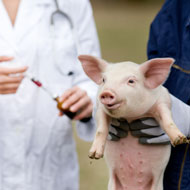
Decision means farmers must limit use of certain drugs
Antibiotic alliance RUMA has taken the decision to adopt the European Medicines Agency ‘Highest Priority’ antibiotics list.
The decision means that UK farmers should aim to cut the use of fluoroquinolones, 3rd and 4th generation cephalosporins and colistin. They should also only use these antibiotics where no other product will be effective for the condition being treated, RUMA explains.
The EMA’s list of highest priority ‘Critically Important Antibiotics’ (CIA) list was identified because of the degree of risk to human health should antimicrobial resistance develop after use in animals.
The World Health Organisation and the US Food and Drug Agency publish slightly different lists of high-priority CIAs, generating much debate about which should be observed. RUMA states that it made the decision to adopt the list after discussions with its members and with the Veterinary Medicines Directorate, which itself follows the EMA’s recommendations.
RUMA secretary general Joh Fitzgerald explains that different agencies produce their own priority lists as they assess different risks: “The conclusion is that in the UK, the list of highest priority CIAs should reflect the recommendations of the EMA’s Antimicrobial Expert Group,” he said.
“This group, comprising a wide range of specialist European organisations, has made its recommendations after examining the impact the use of antibiotics in animals has on public and animal health in the EU, and measures to manage the possible risk to humans.
“Most importantly, the EMA’s recommendations are reassessed as new science emerges.”
Antibiotic sales on the EMA’s CIA list make up a small amount of the 56mg/PCU total antibiotic use in livestock. Veterinary sales data reveal the industry is already acting, with a fall in sales of both fluoroquinolones and 3rd and 4th generation cephalosporins between 2014 and 2015.
Although sales of colistin were static between 2014 and 2015, this was at almost 1/10th of the EMA’s recommended level. According to RUMA, voluntary restrictions brought in at the end of 2015 mean that 2016 sales data should show reductions in colistin use.



 The BSAVA has opened submissions for the BSAVA Clinical Research Abstracts 2026.
The BSAVA has opened submissions for the BSAVA Clinical Research Abstracts 2026.